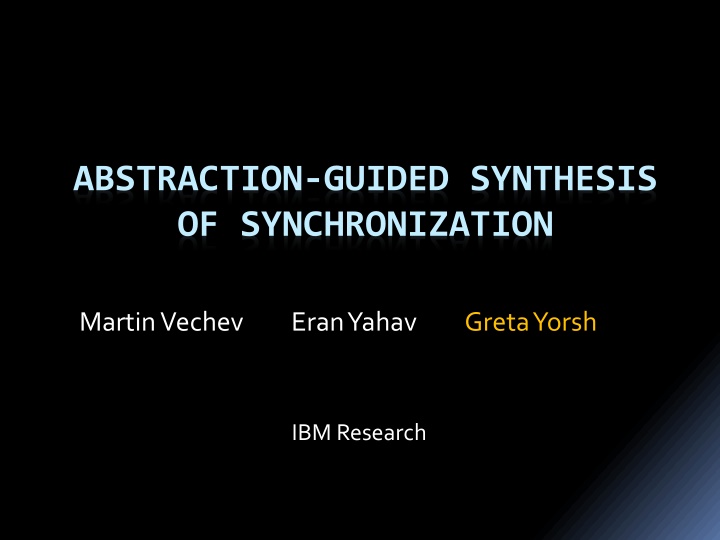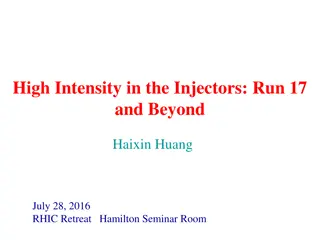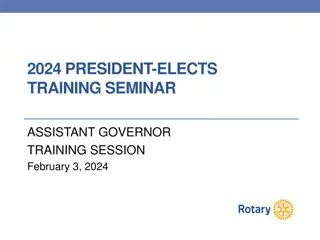
Abstraction-Guided Synchronization Synthesis: Efficient Program Coordination Strategy
Explore the innovative practice of abstraction-guided synthesis in synchronization led by experts Martin Vechev, Eran Yahav, and Greta Yorsh from IBM Research. Discover challenges, standard approaches, and a novel method to automatically infer efficient synchronization for programs, enhancing correctness and performance.
Download Presentation

Please find below an Image/Link to download the presentation.
The content on the website is provided AS IS for your information and personal use only. It may not be sold, licensed, or shared on other websites without obtaining consent from the author. If you encounter any issues during the download, it is possible that the publisher has removed the file from their server.
You are allowed to download the files provided on this website for personal or commercial use, subject to the condition that they are used lawfully. All files are the property of their respective owners.
The content on the website is provided AS IS for your information and personal use only. It may not be sold, licensed, or shared on other websites without obtaining consent from the author.
E N D
Presentation Transcript
ABSTRACTION-GUIDED SYNTHESIS OF SYNCHRONIZATION Martin Vechev Eran Yahav Greta Yorsh IBM Research
Challenge: Correct and Efficient Synchronization T1() T2() T3() { . . } { .. . } { . } atomic atomic atomic Assist the programmer by automatically inferring correct and efficient synchronization
Challenge: Correct and Efficient Synchronization T1() T2() T3() { . . } { .. . } { . } Assist the programmer by automatically inferring correct and efficient synchronization
Challenge Find minimal synchronization that makes the program satisfy the specification Avoid all bad interleaving while permitting as many good interleavings as possible Handle infinite-state programs
A Standard Approach: Abstraction Refinement program Abstract counter example specification Verify Refine abstraction Change the abstraction to match the program
A Standard Approach: Abstraction Refinement concurrent program Restrict synchronized program Abstract counter example safety specification Verify state Refine abstraction Change the program to match the abstraction
Our Approach Synthesis of synchronization via abstract interpretation Compute over-approximation of all possible program executions Add minimal atomics to avoid (over-approximation of) bad interleavings Interplay between abstraction and synchronization Finer abstraction may enable finer synchronization Coarse synchronization may enable coarser abstraction
AGS Algorithm High Level Input: Program P, Specification S, Abstraction Output: Program P satisfying S under = true while(true) { Traces = { | ( P ) and S } if (Traces is empty) return implement(P, ) select Traces if (?) { = avoid( ) if ( is false) abort else = } else { = refine( , ) if ( = ) abort else = } }
Avoiding an interleaving By adding atomicity constraints Atomicity predicate [l1,l2] no context switch allowed between execution of statements at l1 and l2 avoid( ) A disjunction of all possible atomicity predicates that would prevent Example = A1 B1 A2 B2 avoid( ) = [A1,A2] [B1,B2] (abuse of notation)
Example T1 T2 T3 1: x += z 2: x += z 1: z++ 2: z++ 1: y1 = f(x) 2: y2 = x 3: assert(y1 != y2) f(x) { if (x == 1) return 3 else if (x == 2) return 6 else return 5 }
Example: Parity Abstraction y1 y1 6 6 5 5 4 4 3 3 2 2 1 1 y2 y2 0 1 2 3 4 0 1 2 3 4 Parity abstraction (even/odd) Concrete values
Example: Avoiding Bad Interleavings = true while(true) { Traces={ | ( P ) and if (Traces is empty) return implement(P, ) select Traces if (?) { = avoid( ) } else { = refine( , ) } } S } avoid( 1) = [z++,z++] = [z++,z++] = true
Example: Avoiding Bad Interleavings = true while(true) { Traces={ | ( P ) and if (Traces is empty) return implement(P, ) select Traces if (?) { = avoid( ) } else { = refine( , ) } } S } avoid( 2) =[x+=z,x+=z] = [z++,z++] = [z++,z++] [x+=z,x+=z]
Example: Avoiding Bad Interleavings T1 = true while(true) { Traces={ | ( P ) and if (Traces is empty) return implement(P, ) select Traces if (?) { = avoid( ) } else { = refine( , ) } } 1: x += z 2: x += z S } T2 1: z++ 2: z++ T3 1: y1 = f(x) 2: y2 = x 3: assert(y1 != y2) = [z++,z++] [x+=z,x+=z]
Example: Avoiding Bad Interleavings parity parity parity y1 6 6 T1 T1 x+=z; x+=z z++; z++; y1=f(x) y2=x assert y1!= y2 T1 x+=z; x+=z z++; z++; y1=f(x) y2=x assert y1!= y2 x+=z; x+=z z++; z++; y1=f(x) y2=x assert y1!= y2 6 5 5 5 T2 T2 4 T2 4 4 3 3 3 T3 T3 T3 2 2 2 1 1 1 y2 0 1 2 3 4 0 1 2 3 4 0 1 2 3 4 But we can also refine the abstraction
parity parity parity y1 6 6 T1 T1 x+=z; x+=z z++; z++; y1=f(x) y2=x assert y1!= y2 T1 x+=z; x+=z z++; z++; y1=f(x) y2=x assert y1!= y2 x+=z; x+=z z++; z++; y1=f(x) y2=x assert y1!= y2 6 5 5 5 T2 T2 4 T2 4 4 3 3 3 T3 T3 T3 2 2 2 1 1 1 y2 0 1 2 3 4 0 1 2 3 4 0 1 2 3 4 (a) (b) interval (c) interval 6 6 T1 T1 x+=z; x+=z z++; z++; y1=f(x) y2=x assert y1!= y2 x+=z; x+=z z++; z++; y1=f(x) y2=x assert y1!= y2 5 5 T2 T2 4 4 3 3 T3 T3 2 2 1 1 0 1 2 3 4 0 1 2 3 4 (d) (e) octagon octagon 6 6 T1 x+=z; x+=z z++; z++; y1=f(x) y2=x assert y1!= y2 T1 x+=z; x+=z z++; z++; y1=f(x) y2=x assert y1!= y2 5 5 T2 T2 4 4 3 3 T3 T3 2 2 1 1 0 1 2 3 4 0 1 2 3 4 (f) (g)
Quantitative Synthesis Performance: smallest atomic sections Interval abstraction for our example produces the atomicity constraint: ([x+=z,x+=z] [z++,z++]) ([y1=f(x),y2=x] [x+=z,x+=z] [z++,z++]) Minimal satisfying assignments 1 = [z++,z++] 2 = [x+=z,x+=z]
AGS Algorithm More Details Input: Program P, Specification S, Abstraction Forward Abstract Interpretation, taking into account for pruning infeasible interleavings Output: Program P satisfying S under = true while(true) { Traces = { | ( P ) and if (Traces is empty) return implement(P, ) select Traces if (?) { = avoid( ) } else { = refine( , ) } } Order of selection matters S } Choosing between abstraction refinement and program restriction - not always possible to refine/avoid - may try and backtrack interleavings. Backward exploration of invalid Interleavings using to prune infeasible a synchronization mechanism Up to this point did not commit to
Implementability Separation between schedule constraints and how they are realized Can realize in program: atomic sections, locks, Can realize in scheduler: benevolent scheduler T1 T2 1: while(*) { 2: x++ 3: x++ 4: } 1: assert (x != 1) No program transformations (e.g., loop unrolling) Memoryless strategy
Choosing a trace to avoid 0,0 0,0 y=2 if (y==0) 0,1 0,2 2,0 0,0 T1 T2 y=2 if (y==0) 1,1 0,2 2,1 0,2 0: if (y==0) goto L 1: x++ 2: L: 0: y=2 1: x+=1 2: assert x !=y x++ x+=1 2,2 1,2 2,1 1,2 x+=1 3,2 2,2
Examples Intuition If we can show disjoint access we can avoid synchronization Requires abstractions rich enough to capture access pattern to shared data Parity Intervals
Examples Program Refine Steps Avoid Steps Double buffering 1 2 Defragmentation 1 8 3D array update 2 23 Array Removal 1 17 Array Init 1 56
Summary An algorithm for Abstraction-Guided Synthesis Synthesize efficient and correct synchronization Handles infinite-state systems based on abstract interpretation Refine the abstraction and/or restrict program behavior Interplay between abstraction and synchronization Quantitative Synthesis Separate characterization of solution from choosing optimal solutions (e.g., smallest atomic sections)









